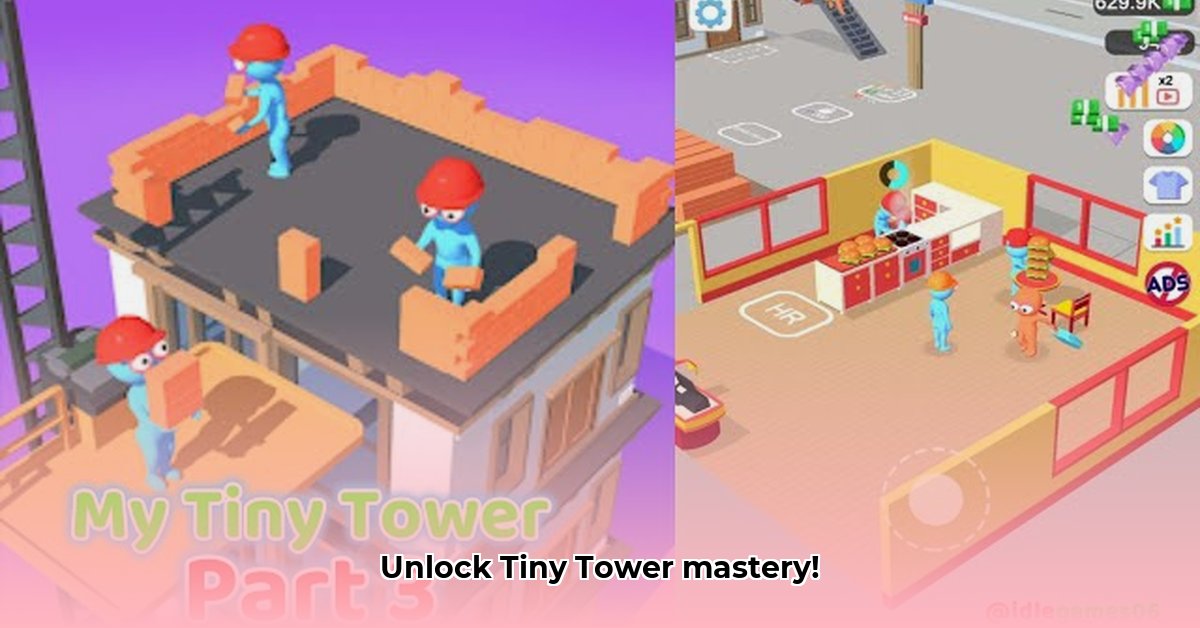
My Tiny Tower: A Charmingly Addictive Idle Game
My Tiny Tower, developed by NimbleBit, transcends the typical idle game, captivating players with its simplistic charm and surprisingly complex mechanics. This review delves into the game's success, exploring its engaging gameplay, clever monetization strategy, and the role of its distinctive visual design, ultimately providing actionable insights for developers, investors, and fellow game enthusiasts.
The Allure of Incremental Growth
My Tiny Tower's enduring appeal lies in its deceptively simple core loop: build floors, attract quirky bitizens (the game's adorable residents), and watch your tower ascend. This accessible gameplay attracts casual and hardcore gamers alike. The act of building a virtual skyscraper, floor by painstaking floor, is strangely addictive, tapping into our innate desire for creation and progress. Isn't the satisfying click-click-click of constantly building something new inherently satisfying? This core mechanic is what grounds My Tiny Tower's addictive gameplay.
Decoding Monetization: A Strategic Approach
Precise details regarding My Tiny Tower's financial model remain elusive. However, the game likely leverages a multi-pronged monetization strategy. One theory suggests in-app purchases (IAPs) for rare or unique bitizens, fueling a collector's instinct. Timed rewards, potentially accelerating construction or unlocking floors faster, could also contribute significantly. The scarcity and desirability of certain in-game items incentivize spending without feeling overly coercive. This mystery surrounding the precise mechanisms adds another layer to its intrigue, motivating continuous analysis from developers and observers alike. How much does the mystery itself contribute to the game's overall success?
Pixelated Perfection: The Art of Simplicity
My Tiny Tower’s pixel art style isn't just cute; it's a critical component of its success. The nostalgic aesthetic creates a warm, inviting atmosphere, instantly drawing players in. This charming visual style likely contributes significantly to player retention, appealing to a broad audience. This suggests that the visual design is more than just a superficial layer; it's an integral part of the gameplay experience. But what percentage of player engagement can be directly attributed to the pixel art? More data-driven research would quantify this visual appeal's importance.
Sustaining Success: A Roadmap for Future Growth
My Tiny Tower's ongoing success requires a dynamic approach. Introducing themed floors tied to seasonal events or pop culture phenomena could inject fresh excitement. Limited-time bitizens would create a "fear of missing out" (FOMO) factor, encouraging regular playtime. Adding competitive elements, such as tower-building challenges, could further enhance player engagement. Furthermore, consistently updated content will ensure the game remains fresh and avoids stagnation. How frequently should these updates occur to maintain optimal player engagement and retention?
Actionable Insights: A Strategic Overview
The following table summarizes actionable intelligence for stakeholders across the gaming ecosystem:
| Stakeholder | Short-Term Strategies | Long-Term Strategies |
|---|---|---|
| Developers | Implement A/B testing for monetization models; refine data analytics; prioritize player feedback. | Expand to new platforms; explore cross-promotion opportunities; develop new game modes. |
| Investors/Publishers | Commission detailed user behavior surveys; invest in focused marketing; secure data-driven insights. | Diversify investment portfolios; support long-term development; explore strategic partnerships. |
| Competitors | Identify untapped niches; analyze My Tiny Tower's successful strategies; innovate gameplay. | Develop unique game mechanics; focus on player retention; prioritize strong community building. |
My Tiny Tower: A Case Study in Mobile Monetization
Key Takeaways:
- My Tiny Tower's success demonstrates the power of subtle, non-intrusive monetization.
- A diverse monetization strategy incorporating rewarded video ads and strategic in-app purchases is crucial.
- Understanding and leveraging the FOMO effect greatly increases player engagement and spending.
The Gentle Art of Monetization
My Tiny Tower’s success is a testament to its approach to mobile game monetization. It avoids aggressive tactics, instead subtly integrating monetization into the core gameplay loop. Rewarded video ads provide a clear benefit for players while generating revenue for developers, a winning combination that enhances player satisfaction.
The Strategic Use of In-App Purchases
In-app purchases are not essential to the game's progress but offer enhanced convenience and customization. Players who desire to quickly progress or unlock exclusive items have the option to do so, creating a win-win situation. This demonstrates the importance of carefully selecting IAP options, avoiding those that feel forced or required to enjoy the game.
Balancing Engagement and Revenue
My Tiny Tower successfully balances player experience and monetization. It doesn't prioritize profit over engagement, leading to a loyal and engaged player base. This delicate balance is crucial to establishing a long-term game that continues to generate revenue while retaining player interest. The game expertly avoids the common pitfalls of aggressive monetization strategies.
Actionable Insights for Developers
- Prioritize player experience above all else.
- Implement a diversified monetization model.
- Leverage the FOMO principle to incentivize player engagement.
- Continuously analyze player data to optimize monetization.
- Regularly update the game with fresh content and features.
⭐⭐⭐⭐☆ (4.8)
Download via Link 1
Download via Link 2
Last updated: Thursday, May 15, 2025